Microstructure and Inertial Characteristics of MHD Suspended SWCNTs and MWCNTs Based Maxwell Nanofluid Flow with Bio-Convection and Entropy Generation Past a Permeable Vertical Cone
Abstract
:1. Introduction
2. Mathematical Analysis
3. Entropy Generation Modeling
4. Engineering Quantities
4.1. Skin Friction Coefficients CFx
4.2. Heat Transfer Rate
4.3. Mass Transfer Rate
4.4. Local Density of Motile Microorganisms
5. Solution Technique
6. Validation of the Results
7. Discussion
7.1. Temperature
7.2. Micro Rotation Profile
7.3. Concentration
7.4. Local Density of Motile Microorganisms
7.5. Entropy Optimization
7.6. Engineering Quantities
7.7. Surface Drag Force
7.8. Heat Transfer Rate
7.9. Mass Transfer Rate
7.10. Local Density of Motile Microorganisms Nnx
8. Conclusions
- The motion of the nanoparticle increases for enlarging values of solid volume fraction (Φ).
- For a larger value of magnetic parameter (M) the Lorentz forces enhance which raises the forces of resistance of the Maxwell micropolar motion which in turn reduces velocity f′(η).
- The augmented Nr reduced the fluid motion.
- The momentum boundary layer reduces with enhances value of k1.
- Micro rotation velocity S(η) augmented with a higher value of K, γ*, and α.
- Augmentation in the θ(η) with enhancement radiation parameter Rd is observed.
- The higher value of Ec amplified the kinetic energy of CNTs Maxwell micropolar nanofluid molecules, which thus enhanced the heat transmission rate.
- The augmented rate of Gr reduces the concentration of Maxwell micropolar nanofluid.
- As the estimate of the number of Peclets increases, the number of motion densities also increases.
- With the rise in estimations of Pe, h(η) are increases.
- For both CNTs, f′(η) intensifies against rising values of suction. For rising values of Nr, θ(η) is reducing.
- For these CNTs, g(η) is reduced on the increasing of n.
- For the growth estimates of Nr, Shx is reduced and raises against numerical values of Cr.
- For solid volume fraction Cf is increased.
- Magnetic force M reduces Nux.
- A comparison between the present and previous outcomes for justification is given in Table 1.
Author Contributions
Funding
Acknowledgments
Conflicts of Interest
Abbreviations
| Prandtl number | |
| Porous parameter | |
| Magnetic parameter | |
| Schmidt number | |
| Solutal stratification | |
| Vortex velocity or material parameter | |
| Heat suction/Injection parameter | |
| Bio-convection Lewis number | |
| Radiation parameter | |
| Bio-convection Rayleigh number | |
| Buoyancy ratio parameter | |
| Bio-convection Rayleigh number | |
| Chemical reaction parameter | |
| Boit number | |
| Bio-convection Peclet number | |
| Bio-convection constant | |
| Temperature difference parameter | |
| Brinkman number | |
| concentration difference parameter, and | |
| diffusive constant parameter | |
| Reynold number |
References
- Choi, S.U.; Eastman, J.A. Enhancing Thermal Conductivity of Fluids with Nanoparticles; Argonne National Lab: Lemonte, IL, USA, 1995. [Google Scholar]
- Chen, L.; Liu, J.; Fang, X.; Zhang, Z. Reduced graphene oxide dispersed nanofluids with improved photo-thermal conversion performance for direct absorption solar collectors. Sol. Energy Mater. Sol. Cells 2017, 163, 125–133. [Google Scholar] [CrossRef]
- Oudina, F.M. Convective heat transfer of Titania nanofluids of different base fluids in cylindrical annulus with discrete heat source. Heat Transf. Asian Res. 2019, 48, 135–147. [Google Scholar] [CrossRef] [Green Version]
- Oudina, F.M. Numerical modeling of the hydrodynamic stability in vertical annulus with heat source of different lengths. Eng. Sci. Technol. Int. J. 2017, 20, 1324–1333. [Google Scholar]
- Sheikholeslami, M.; Shah, Z.; Shafee, A.; Khan, I.; Tlili, T. Uniform magnetic force impact on water based nanofluid thermal behavior in a porous enclosure with ellipse shaped obstacle. Sci. Rep. 2019, 1196. [Google Scholar] [CrossRef] [Green Version]
- Chougule, S.S.; Nirgude, V.V.; Gharge, P.D.; Mayank, M.; Sahu, S.K. Heat Transfer enhancements of low volume concentration CNT/water nanofluid and wire coil inserts in a circular tube. Energy Procedia 2016, 90, 552–558. [Google Scholar] [CrossRef]
- Herrmann-Priesnitz, B.; Calderón-Muñoz, V.R.; Valencia, A.; Soto, R. Thermal design exploration of a swirl flow microchannel heat sink for high heat flux applications based on numerical simulations. Appl. Therm. Eng. 2016, 109, 22–34. [Google Scholar] [CrossRef]
- Ding, Y.; Alias, H.; Wen, D.; Williams, R.A. Heat transfer of aqueous suspensions of carbon nanotubes (CNT nanofluids). Int. J. Heat Mass Transf. 2006, 49, 240–250. [Google Scholar] [CrossRef]
- Pop, I.; Watanabe, T. Free convection with uniform suction or injection from a vertical cone for constant wall heat flux. Int. Commun. Heat Mass Transf. 1992, 19, 275–283. [Google Scholar] [CrossRef]
- Xu, H. Modelling unsteady mixed convection of a nanofluid suspended with multiple kinds of nanoparticles between two rotating disks by generalized hybrid model. Int. Comm. Heat Mass Tran. 2019, 108, 104275. [Google Scholar] [CrossRef]
- Rohsenow, W.M.; Hartnett, J.P.; Cho, Y.I. Handbook of Heat Transfer; McGraw-Hill Book Co.: New York, NY, USA, 1985. [Google Scholar] [CrossRef]
- Sharma, K.V.; Sundar, L.S.; Sarma, P.K. Estimation of heat transfer coefficient and friction factor in the transition flow with low volume concentration of Al2O3 nano fluid flowing in a circular tube and with wisted tape insert. Int. Commun. Heat Mass Transf. 2009, 36, 503–507. [Google Scholar] [CrossRef]
- Zhang, Y. Modified computational methods using effective heat capacity model for the thermal evaluation of PCM outfitted walls. Int. Commun. Heat Mass Transf. 2019, 108, 104278. [Google Scholar] [CrossRef]
- Sun, X.; Zhang, Q.; Medina, M.A.; Lee, K.O. Experimental observations on the heat transfer enhancement caused by natural convection during melting of solid–liquid 17 phase change materials (PCMs). Appl. Energy 2016, 162, 1453–1461. [Google Scholar] [CrossRef]
- Phuoc, T.X.; Massoudi, M.; Chen, R.H. Viscosity and thermal conductivity of nanofluids containing carbon nanotubes stabilized by Chitosan. Int. J. Therm. Sci. 2011, 50, 12–18. [Google Scholar] [CrossRef]
- Harish, S.; Ishikawa, K.; Einarsson, E.; Aikawa, S.; Chiashi, S.; Shiomi, J.; Maruyama, S. Enhanced thermal conductivity of ethylene glycol with single-walled carbon nanotube inclusions. Int. J. Heat Mass Transf. 2012, 55, 3885–3890. [Google Scholar] [CrossRef]
- Hayat, T.; Muhammad, T.; Shehzad, S.A.; Chen, G.Q.; Abbas, I.A. Interaction of magnetic field in flow of Maxwell nanofluid with convective effect. J. Magn. Magn. Mater. 2015, 389, 48–55. [Google Scholar] [CrossRef]
- Bejan, A. A study of entropy generation in fundamentsl convective heat transfer. J. Heat Trans. 1979, 101, 718–725. [Google Scholar] [CrossRef]
- Ellahi, R.; Hassan, M.; Zeeshan, A.; Khan, A.A. The shape effects of nanoparticles suspended in HFE-7100 over wedge with entropy generation and mixed convection. Appl. Nanosci. 2016, 6, 641–651. [Google Scholar] [CrossRef] [Green Version]
- Sheikholeslami, M.; Jafaryar, M.; Hedayat, M.; Shafee, A.; Li, Z.; Khang Nguyen, T.; Bakouri, M. Heat transfer and turbulent simulation of nanomaterial due to compound turbulator including irreversibility analysis. Int. J. Heat Mass Transf. 2019, 137, 1290–1300. [Google Scholar] [CrossRef]
- Ramzan, M.; Mohammad, M.; Howari, F. Magnetized suspended carbon nanotubes based nanofluid flow with bio-convection and entropy generation past a vertical cone. Sci. Rep. 2019, 9, 12225. [Google Scholar] [CrossRef] [PubMed]
- Sarafraz, M.M.; Reza Safaei, M.; Goodarzi, M.; Arjomandi, M. Reforming of methanol with steam in a micro-reactor with Cu–SiO2 porous catalyst. Int. J. Hydrogen Energy 2019, 44, 19628–19639. [Google Scholar] [CrossRef]
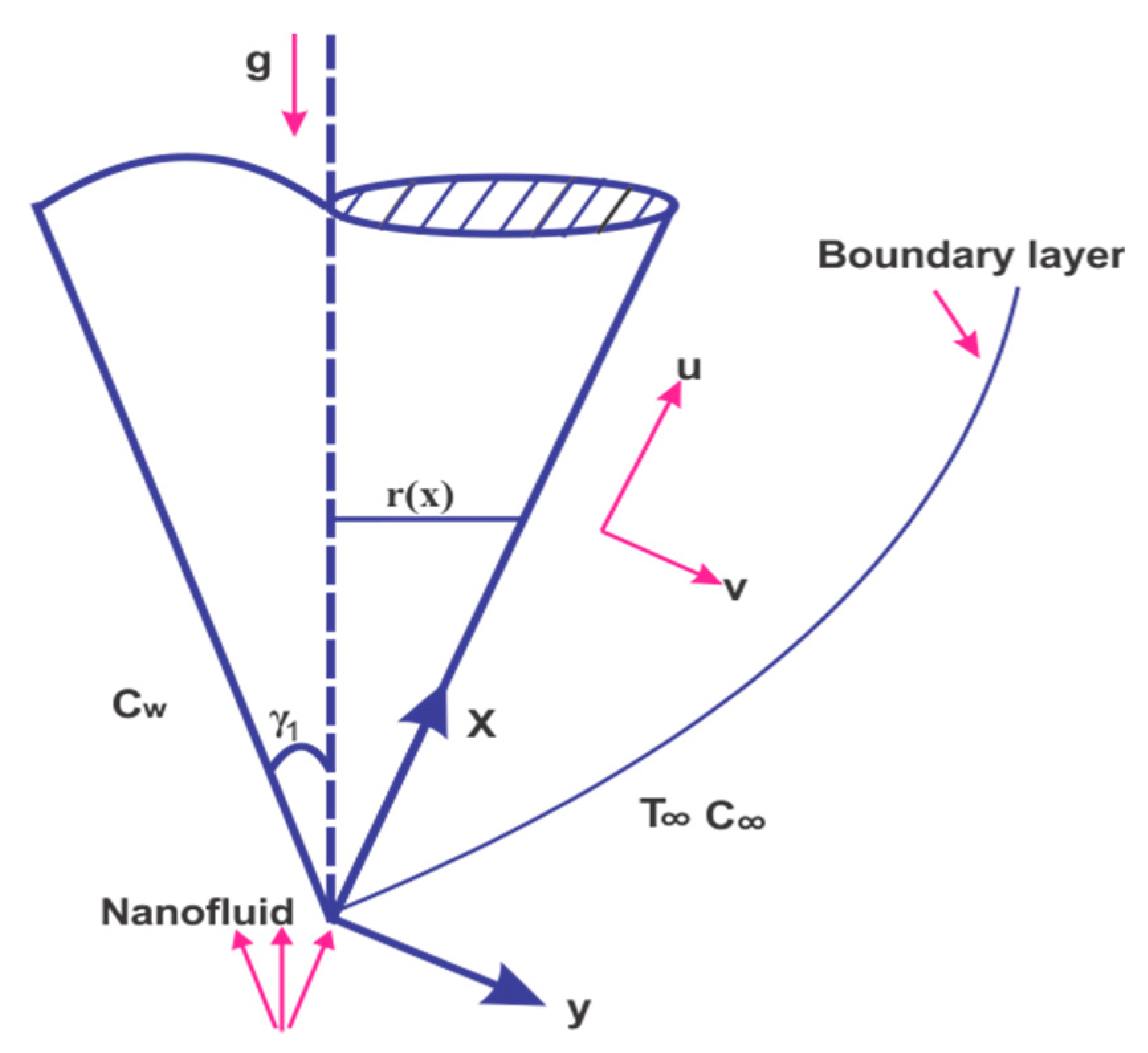

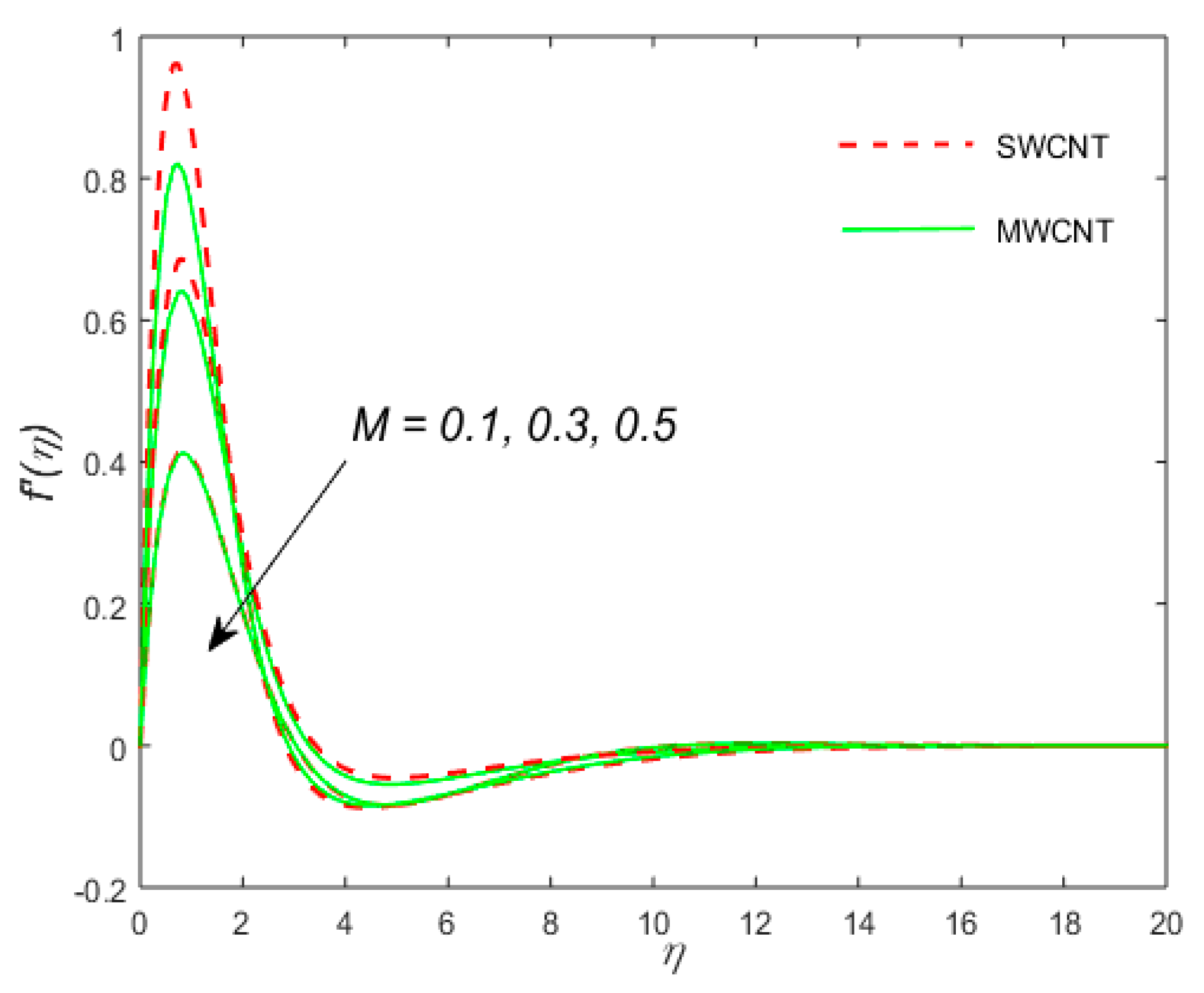
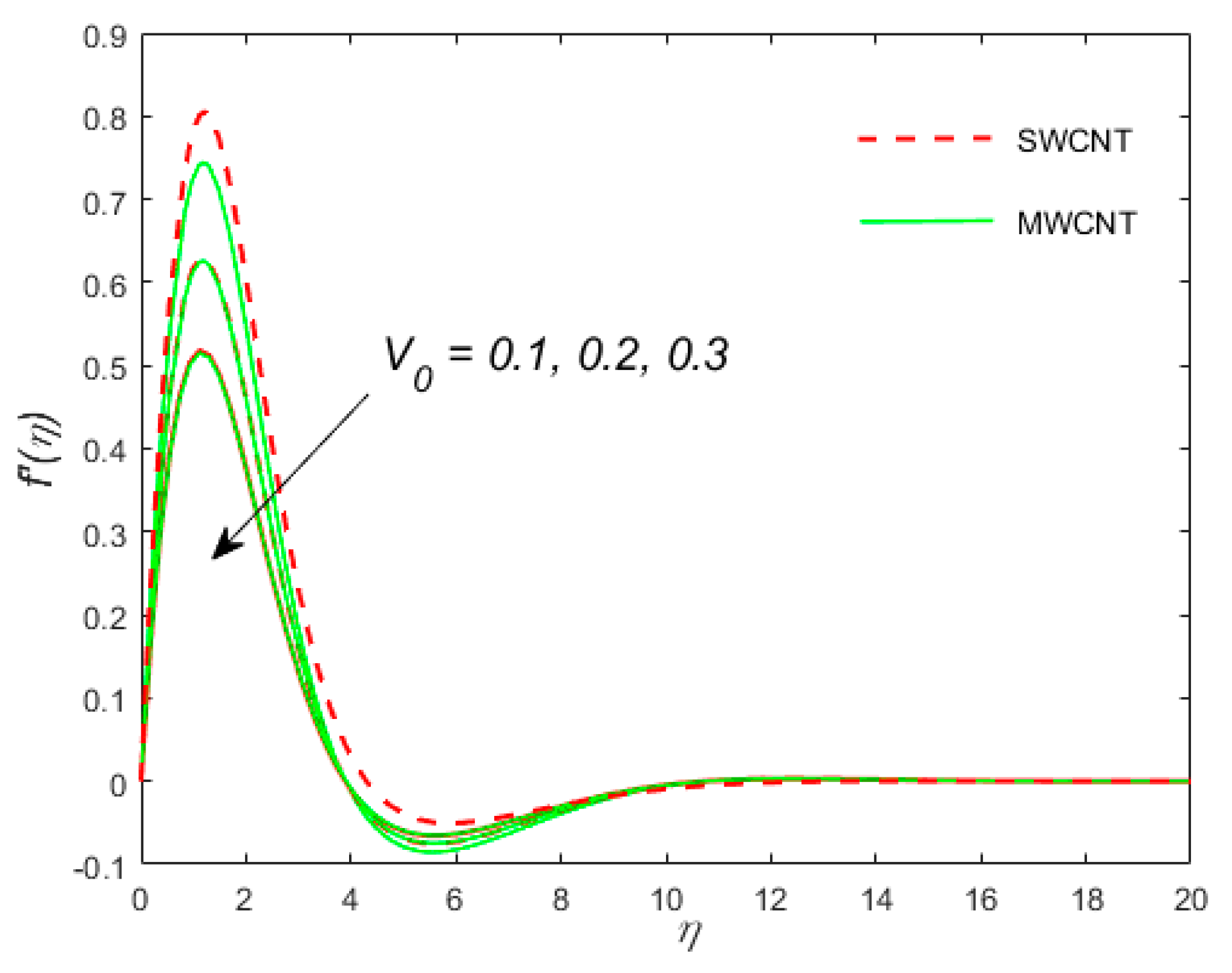
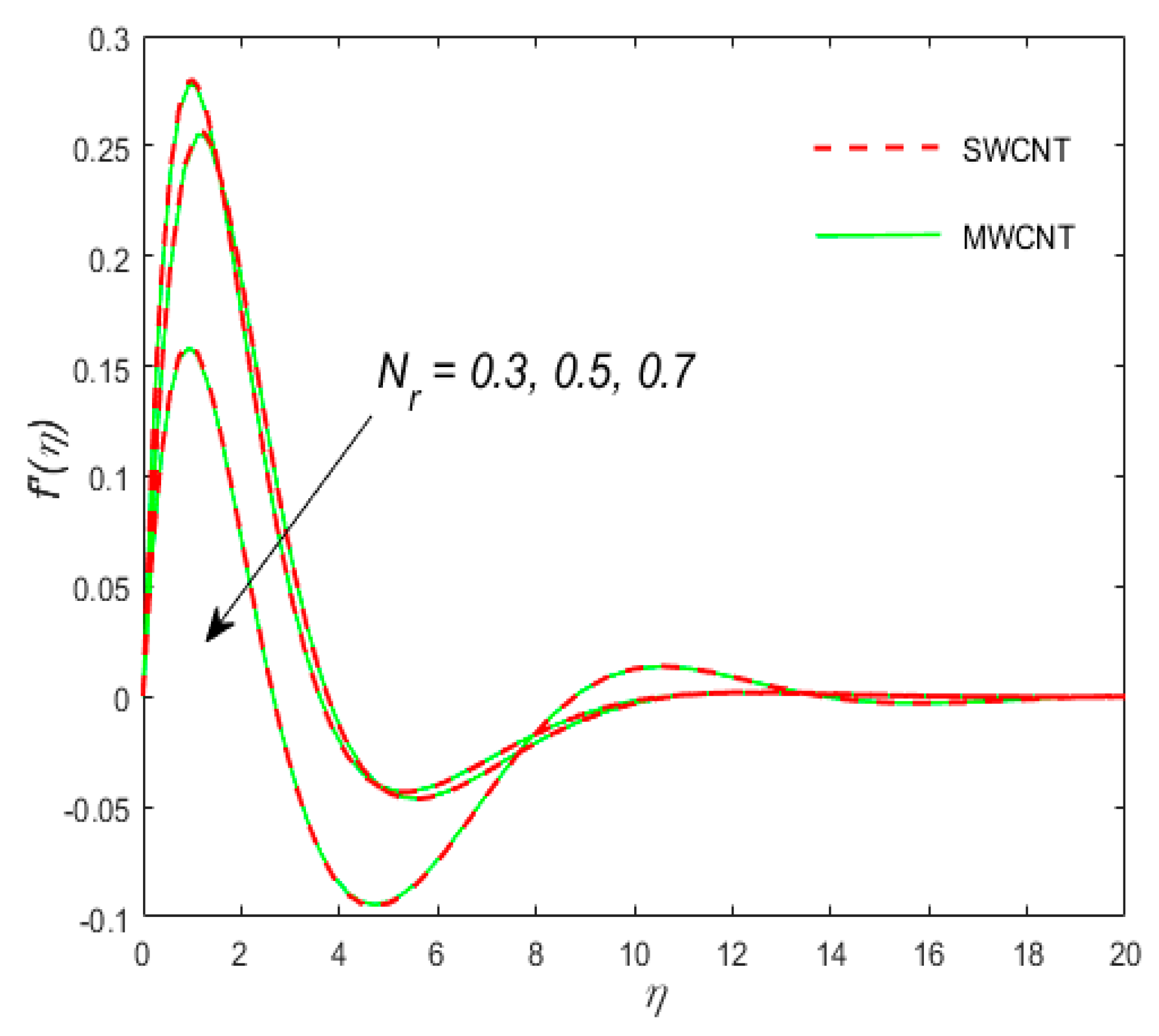
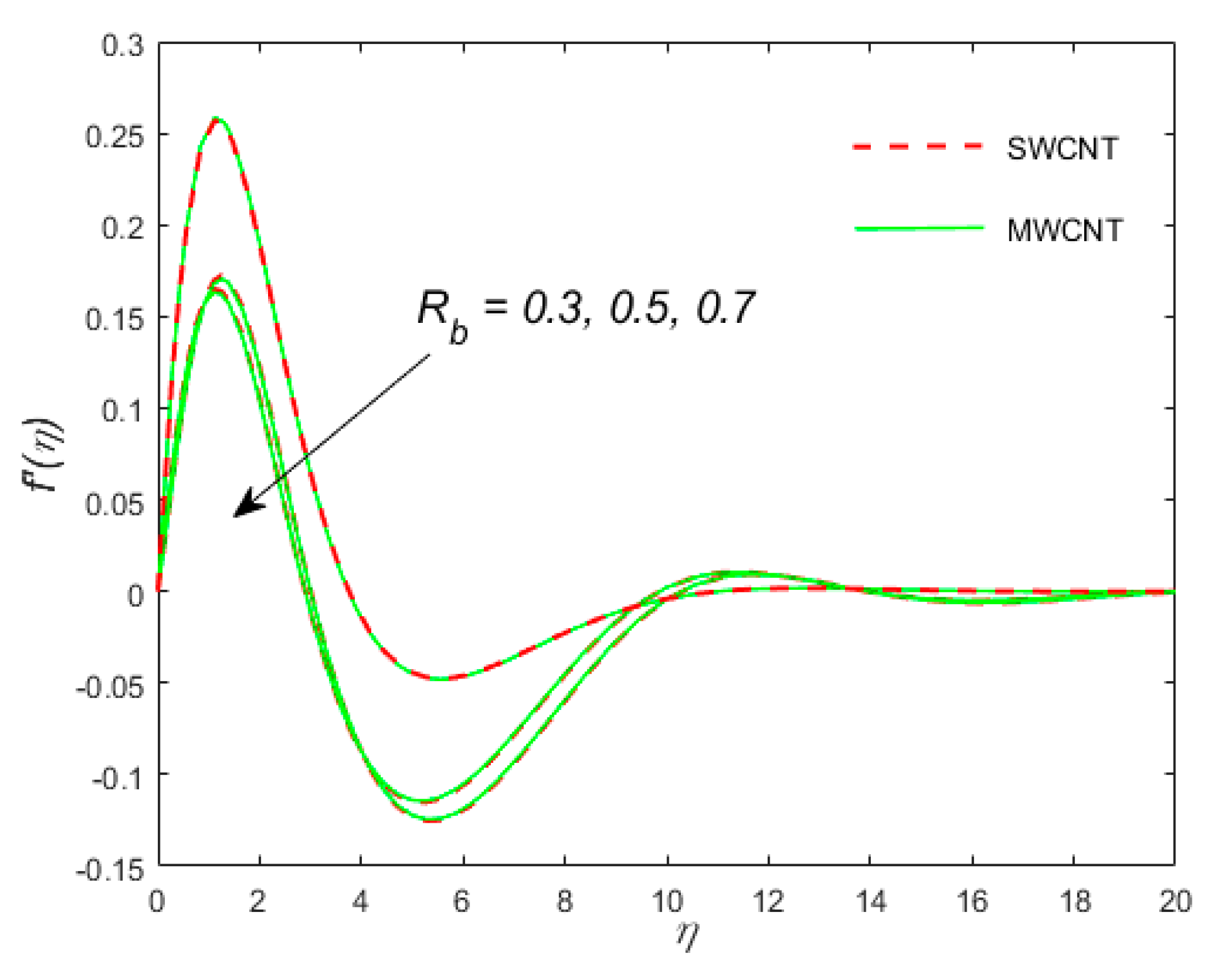
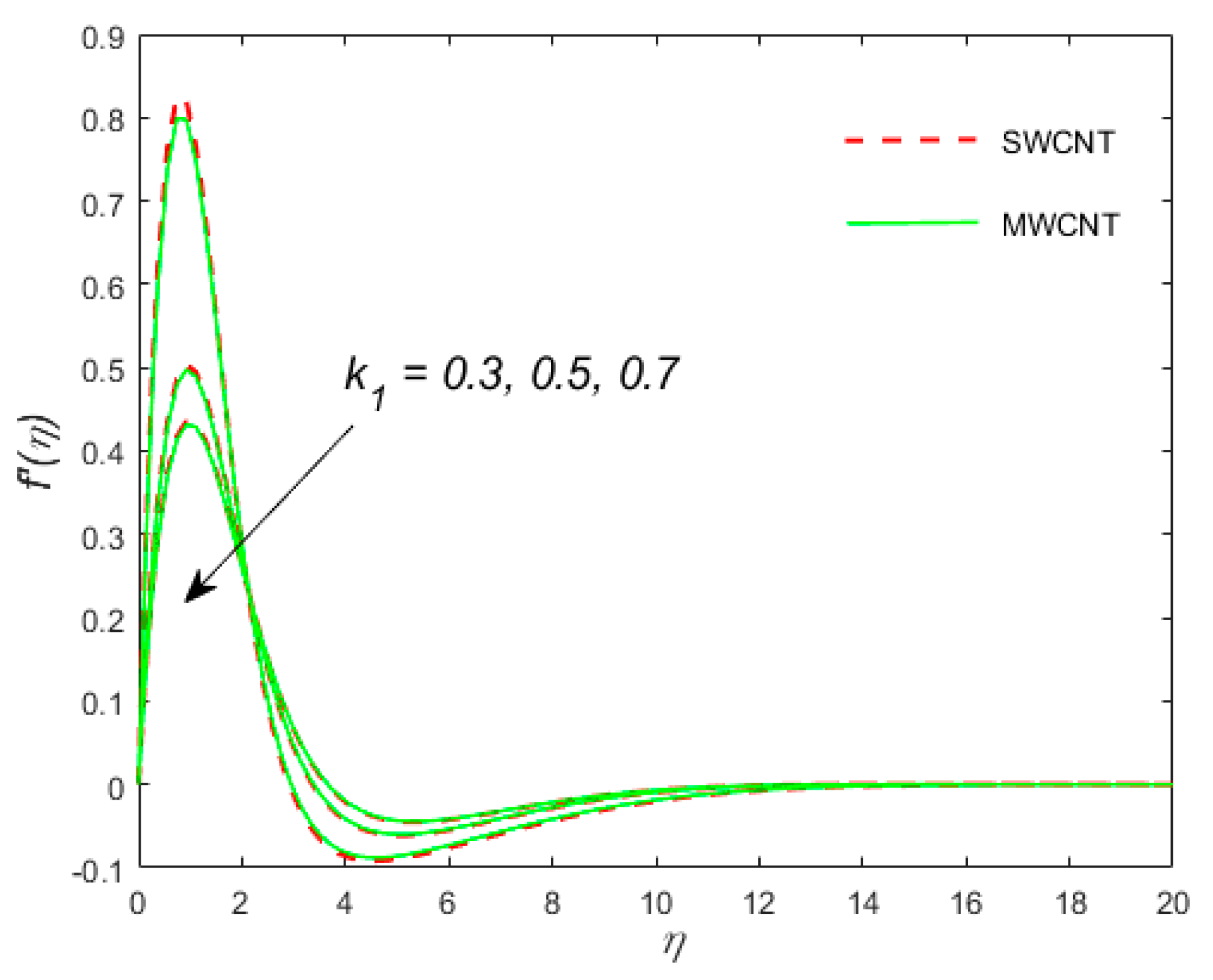
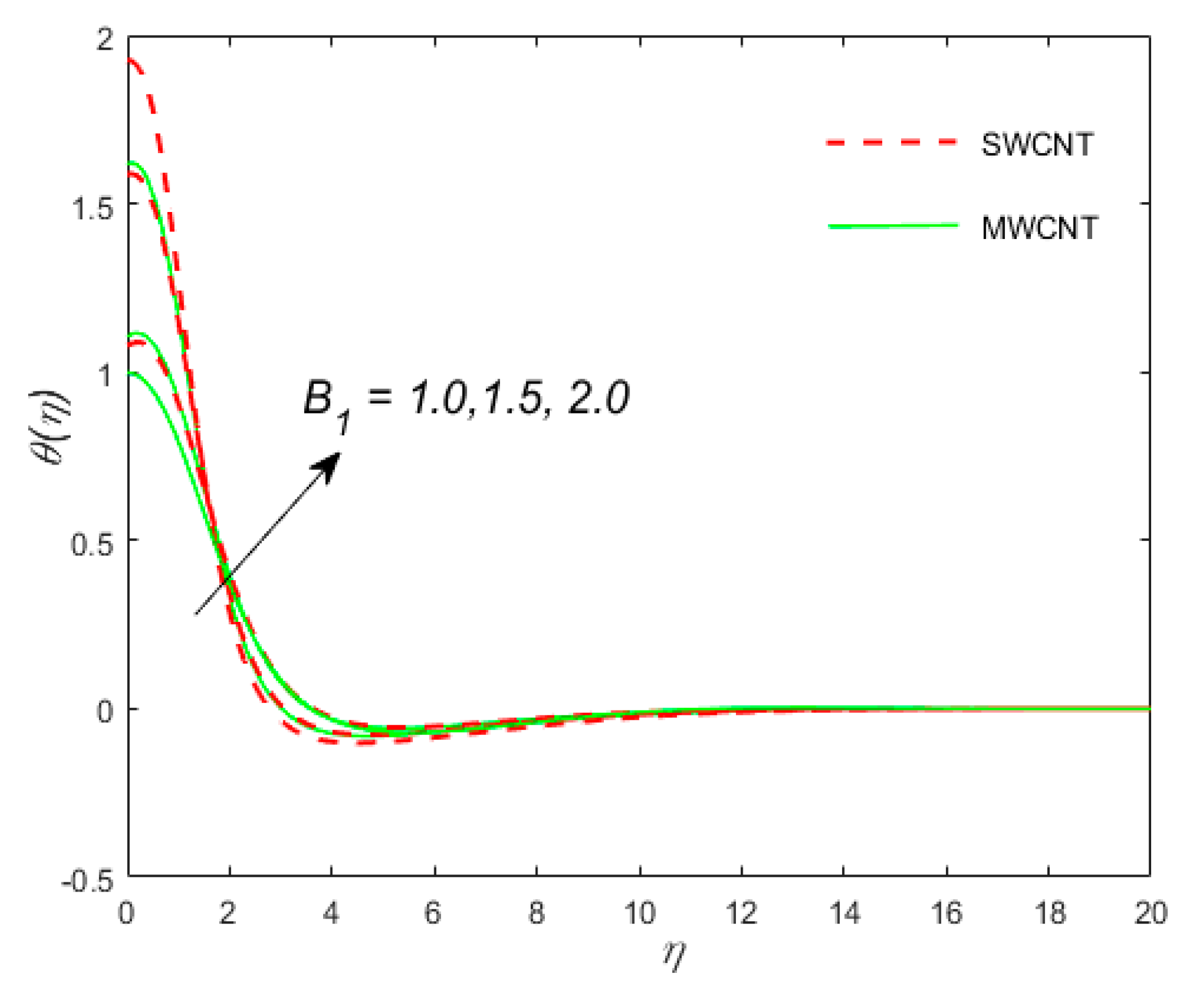

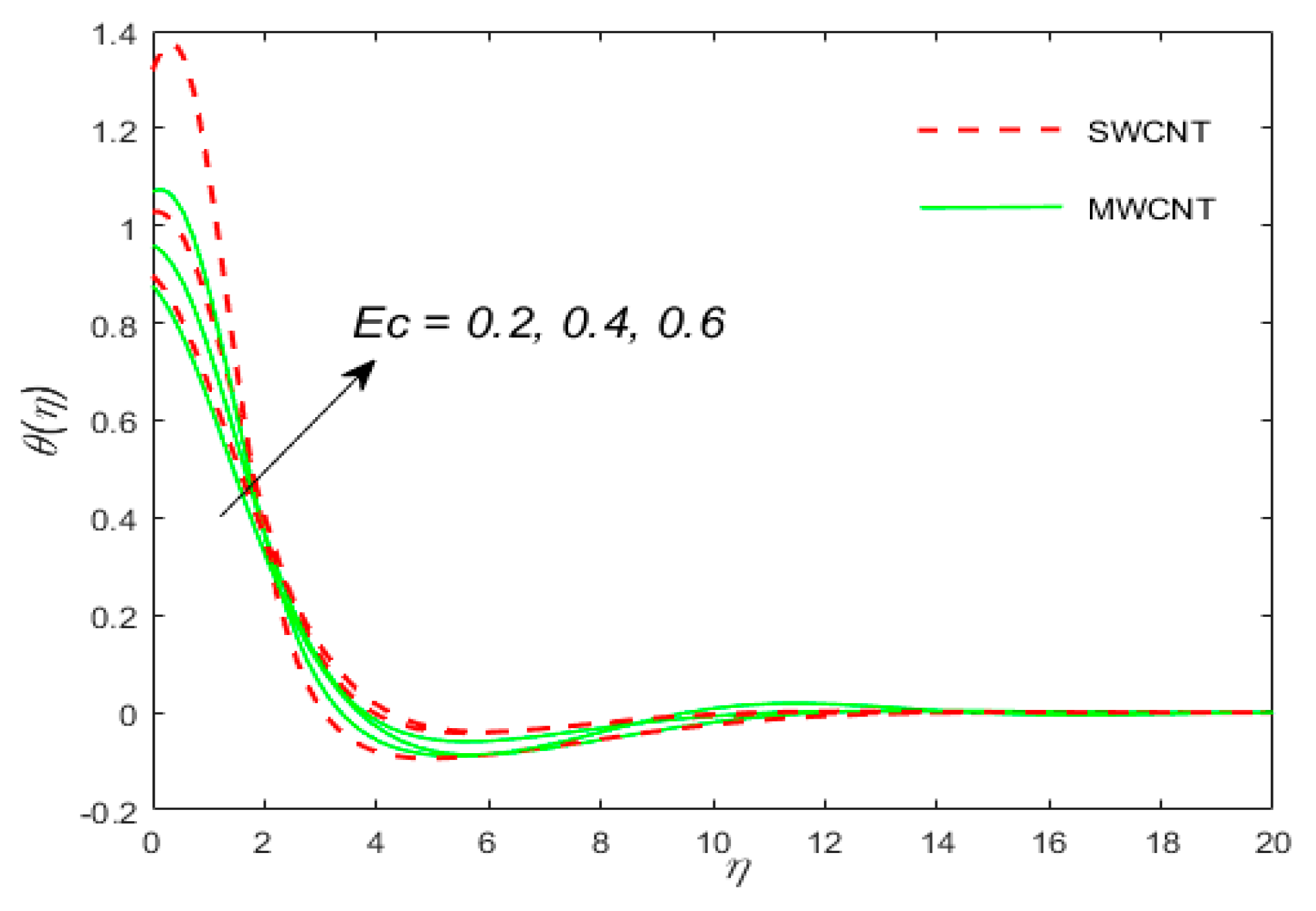



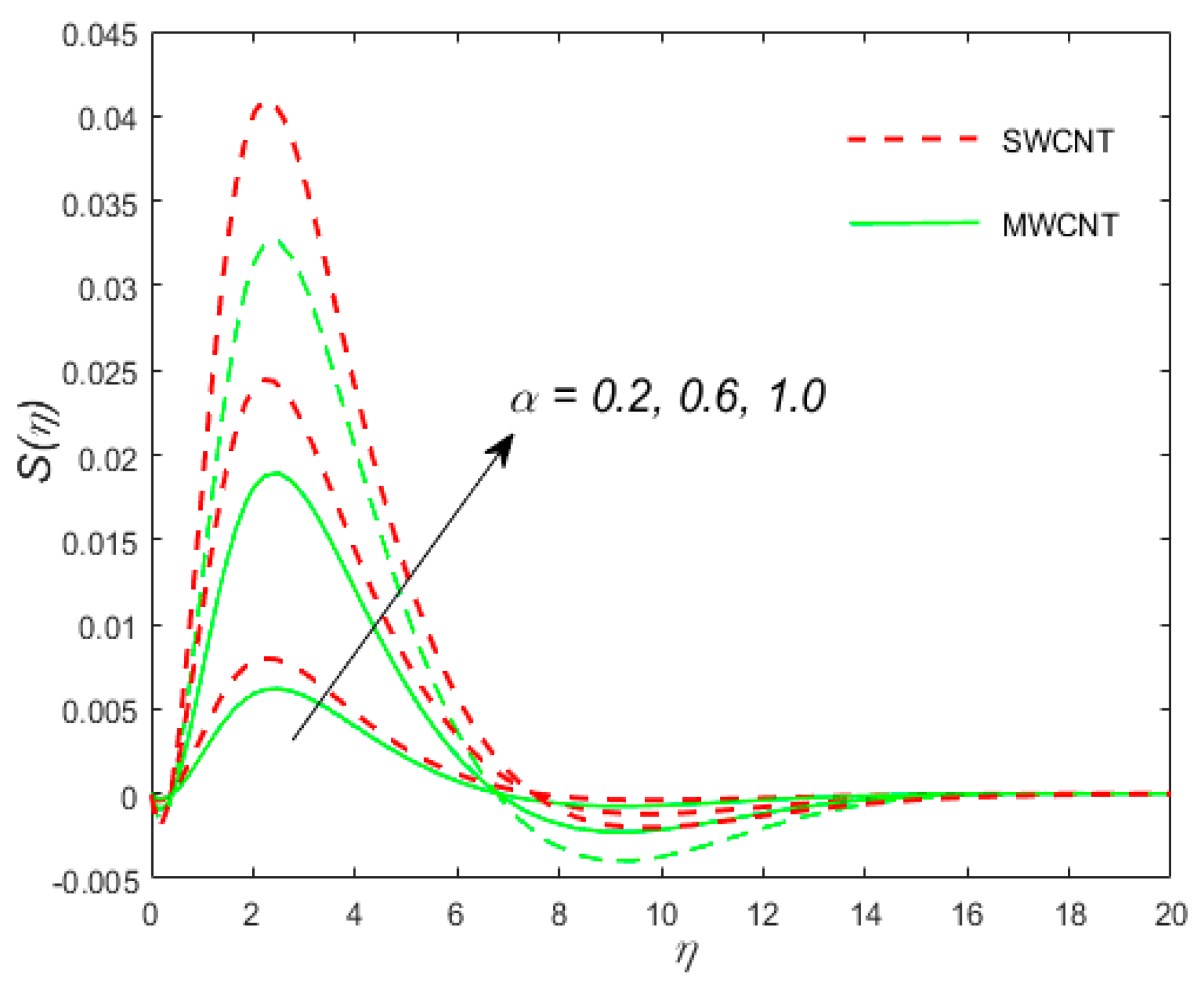
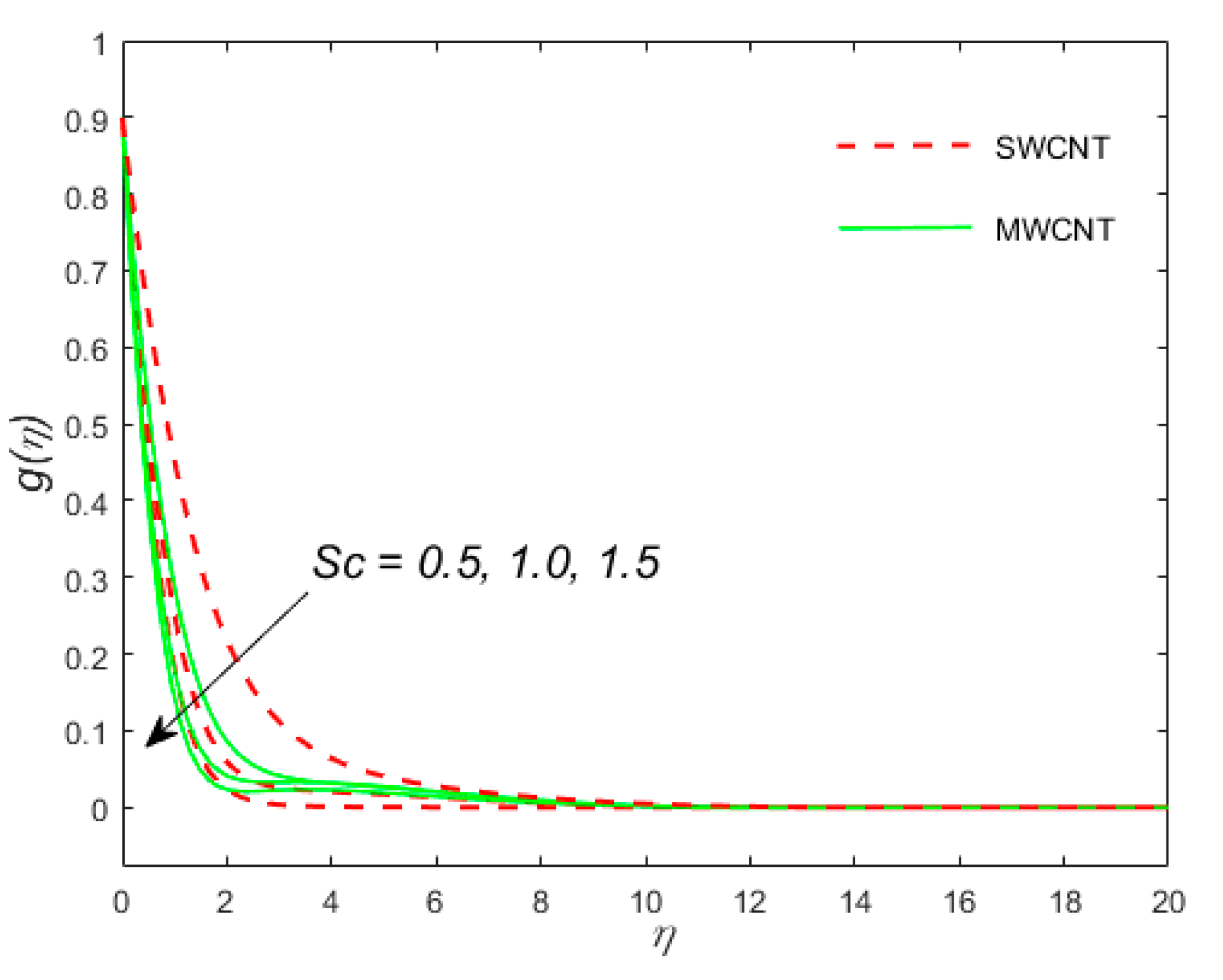
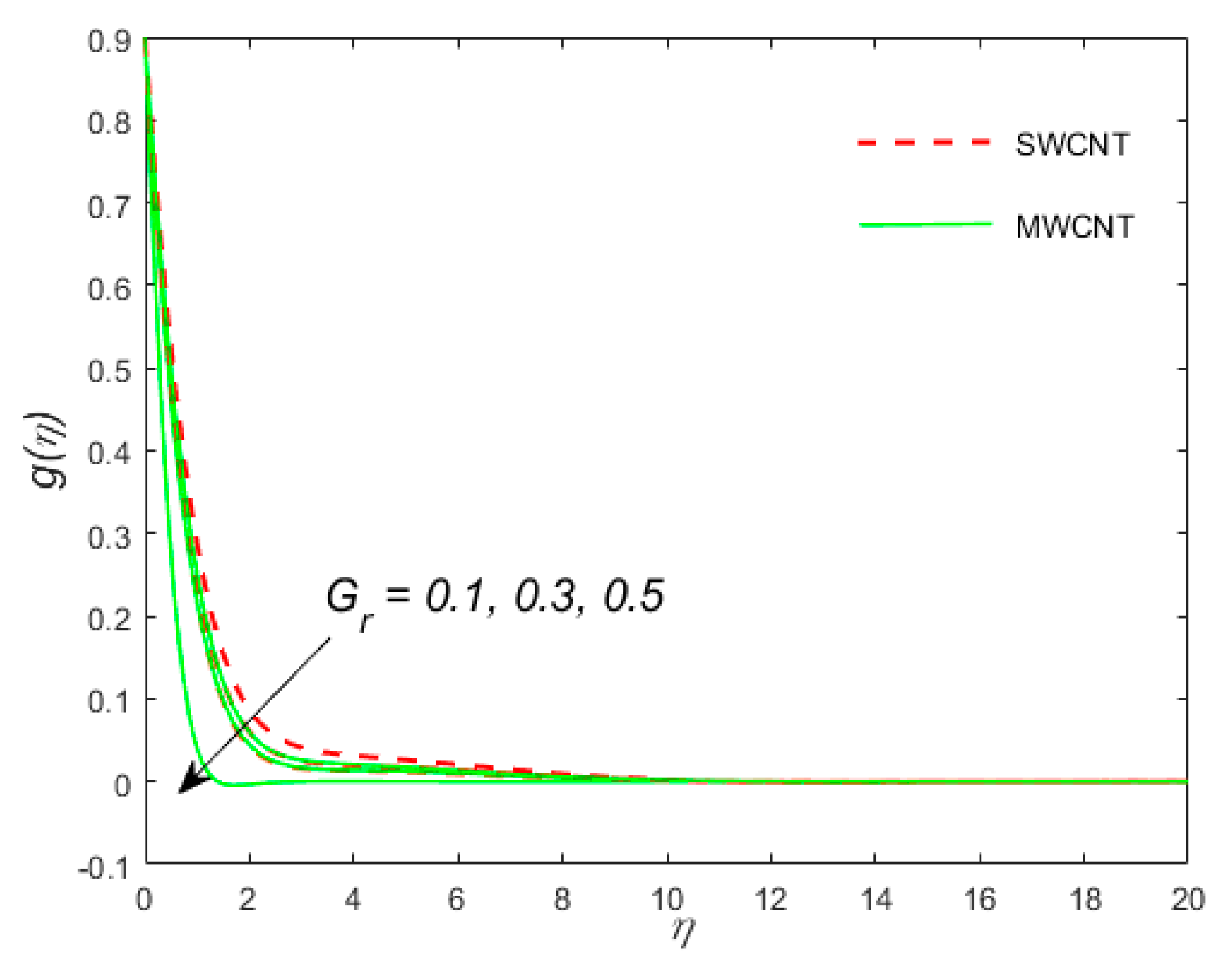

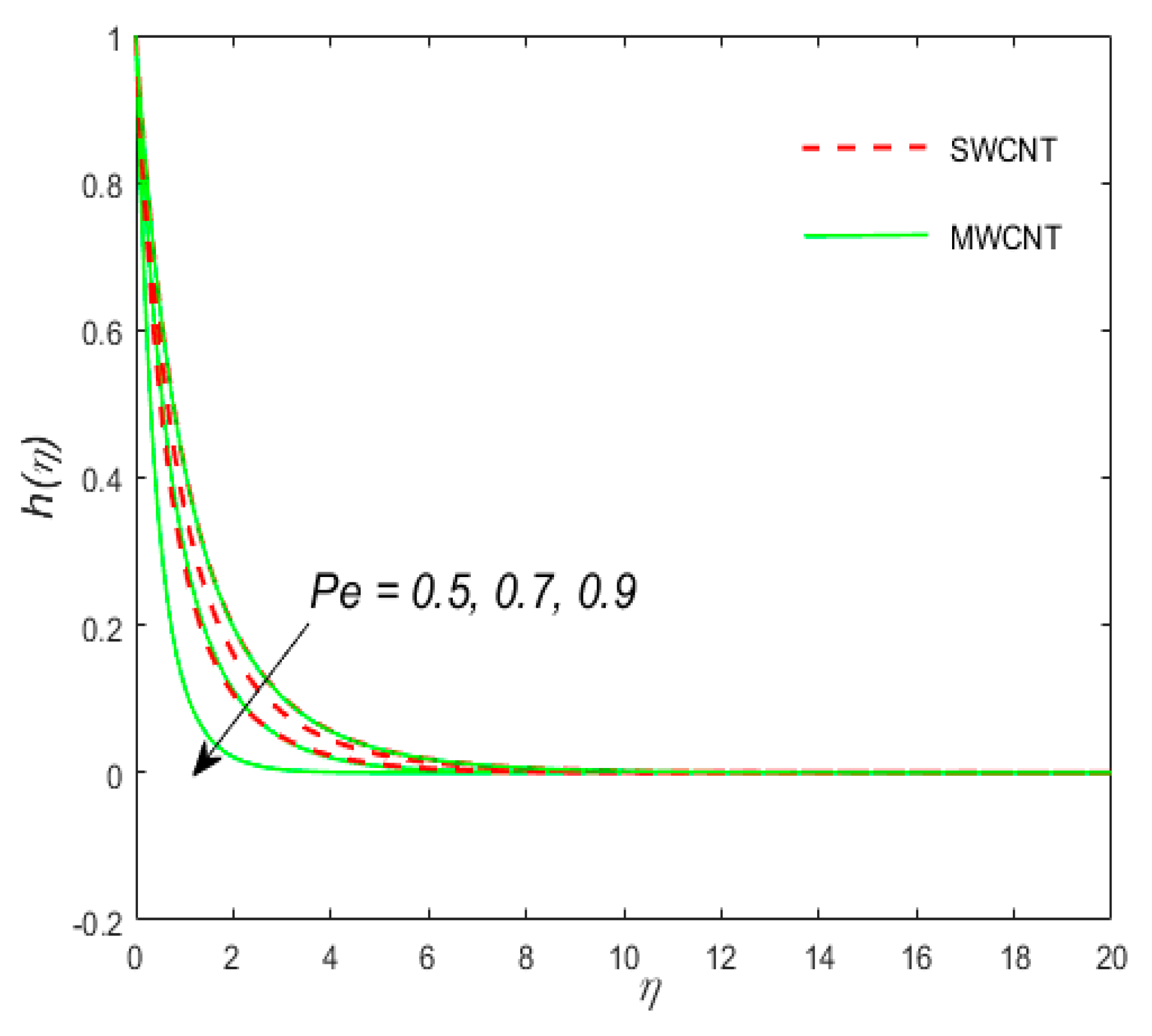
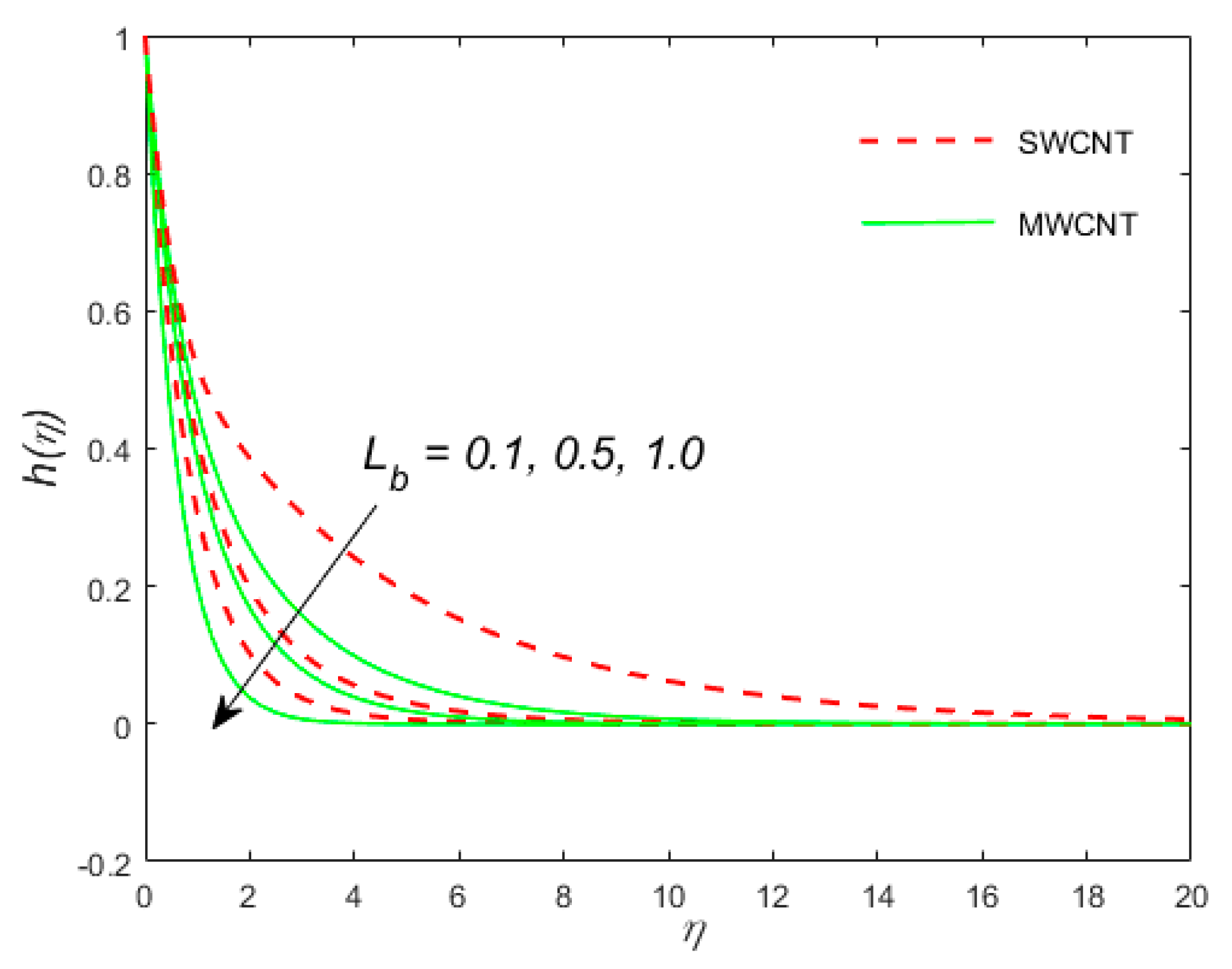
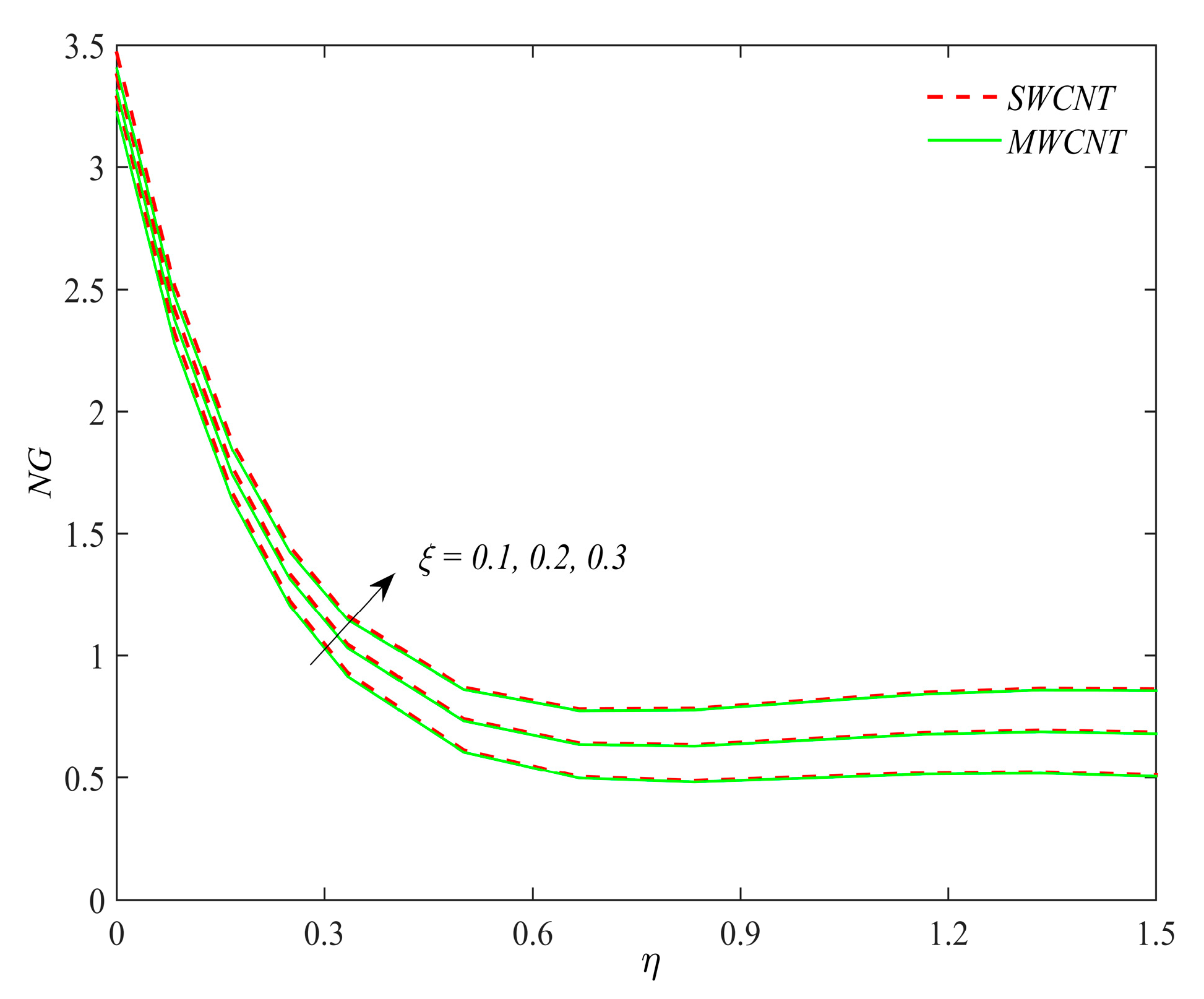

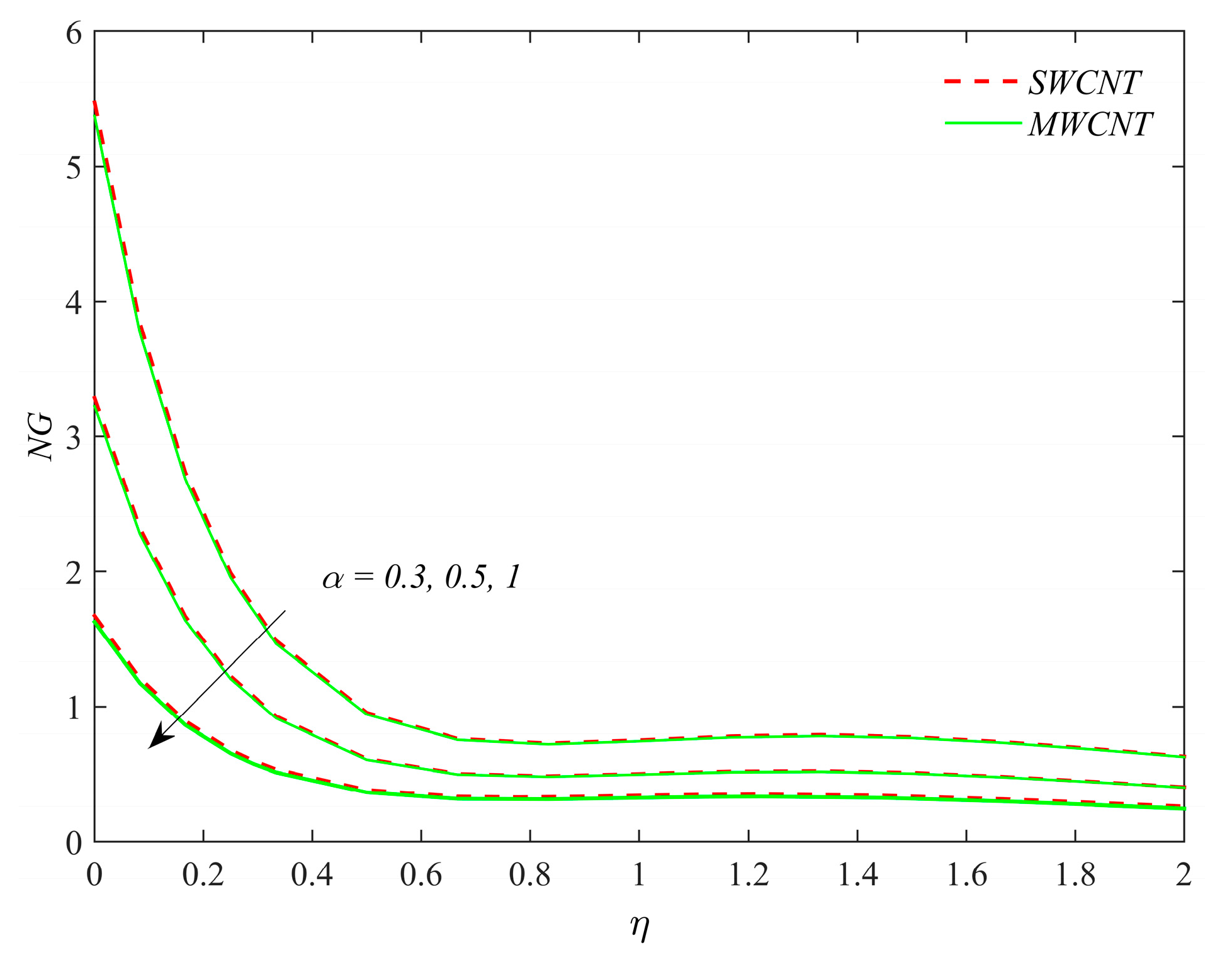
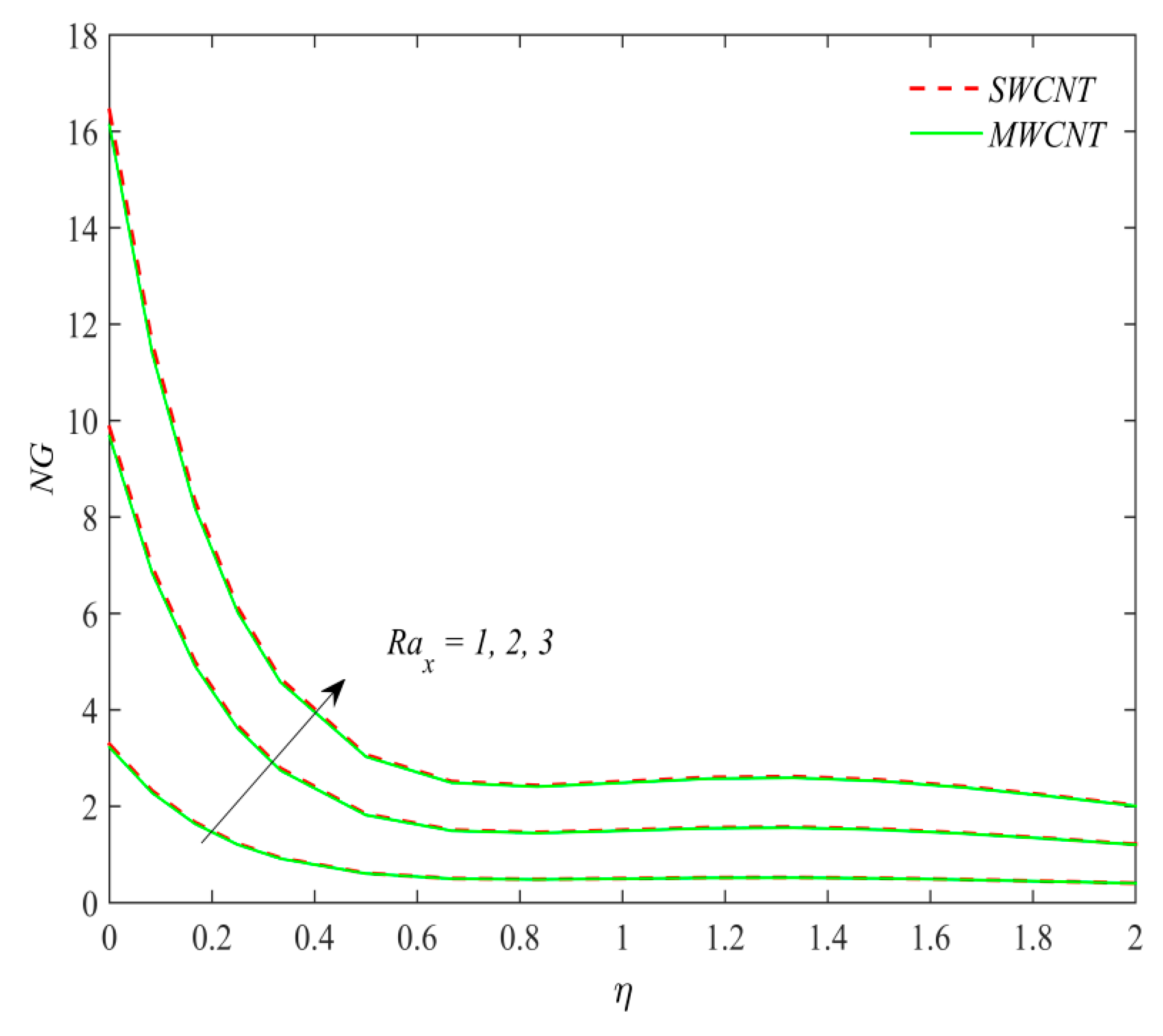
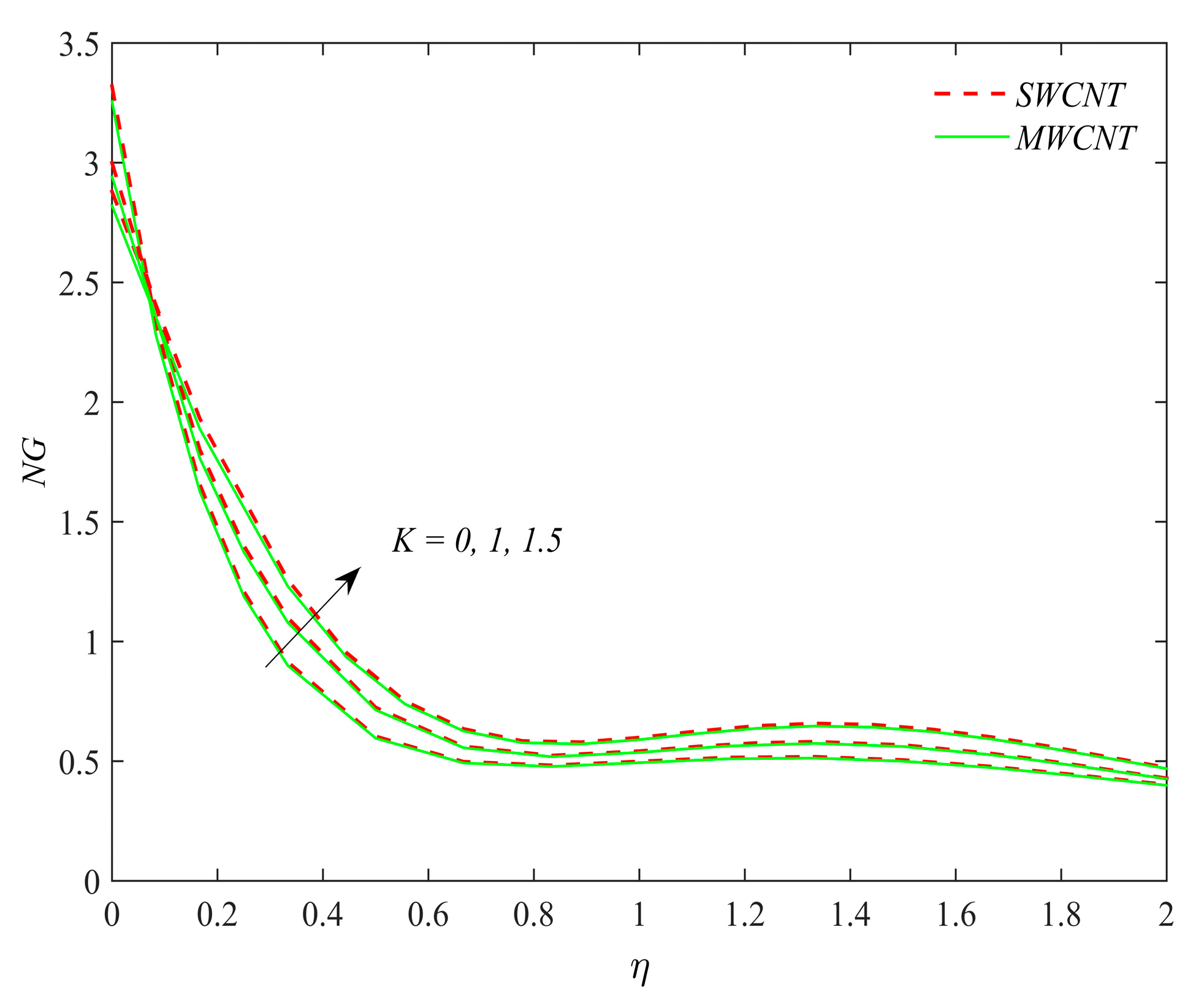
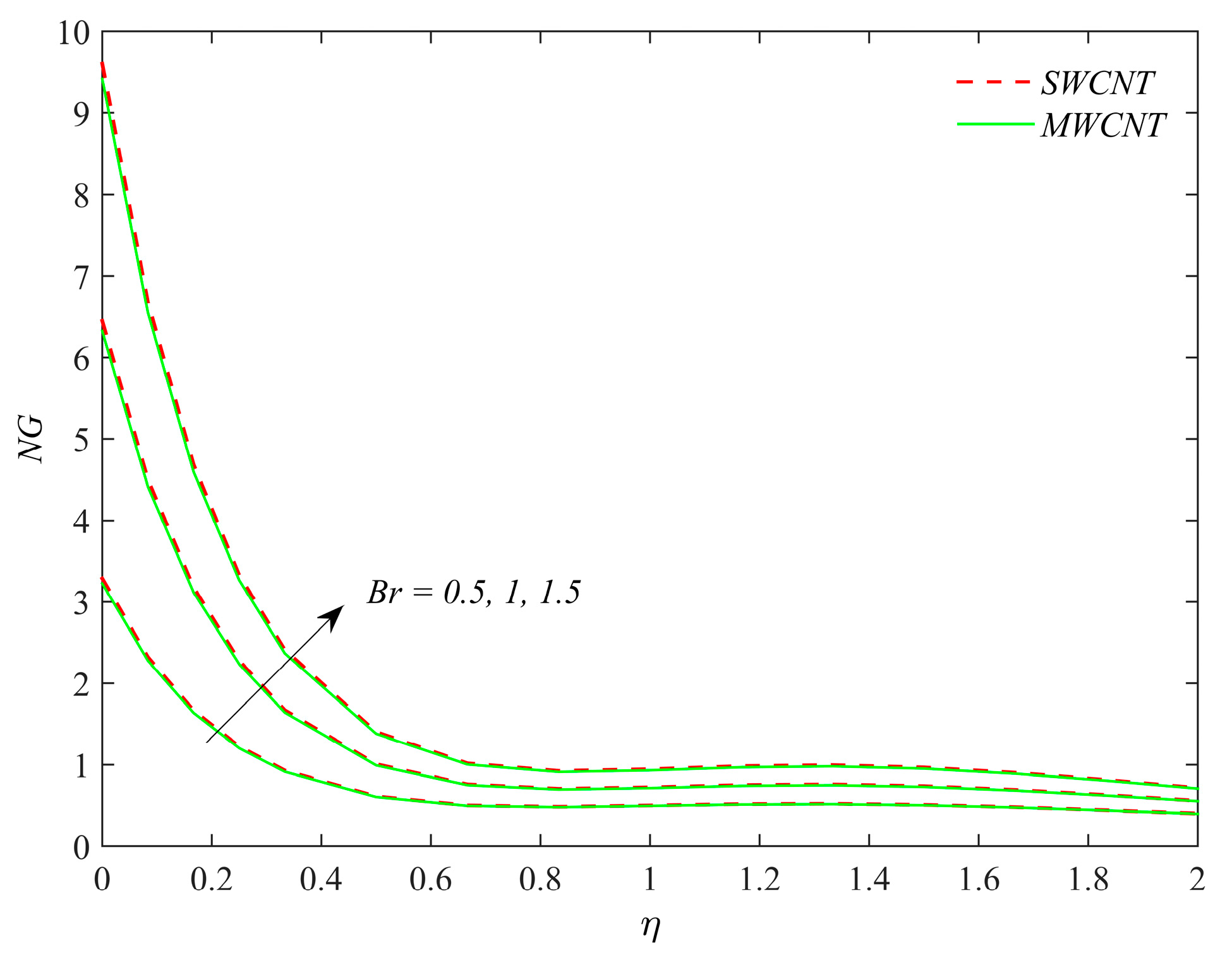
| Sc | Ramzan et al. [21] | Present Results | ||
|---|---|---|---|---|
| −g′ (0) SWCNT | −g′ (0) MWCNT | −g′ (0) SWCNT | −g′ (0) MWCNT | |
| 0.1 | 0.31891 | 0.31882 | 0.3189450 | 0.3188567 |
| 0.5 | 0.50221 | 0.50155 | 0.5022674 | 0.5015768 |
| 0.9 | 0.74207 | 0.74087 | 0.7420467 | 0.7408564 |
| Material | Water | SWCNT | MWCNT |
|---|---|---|---|
| Cp (j/kgK) | 4179 | 425 | 796 |
| ρ (kg/m3) | 997.1 | 2600 | 1600 |
| k (W/mK) | 0.613 | 6600 | 3000 |
| Φ | k1 | V0 | Rb | C | ||
|---|---|---|---|---|---|---|
| SWCNTs | MWCNTs | |||||
| 0.01 | 0.5 | 1.0 | 0.1 | 0.1 | 1.8355 | 1.7511 |
| 0.03 | – | – | – | – | 2.2996 | 1.8007 |
| 0.05 | – | – | – | – | 2.4875 | 1.8673 |
| – | 0.5 | – | – | – | 1.1596 | 1.1465 |
| – | 0.7 | – | – | – | 1.4990 | 1.4987 |
| – | 0.9 | – | – | – | 1.8355 | 1.8165 |
| – | – | 0.5 | – | – | 2.8463 | 2.7389 |
| – | – | 0.6 | – | – | 2.5630 | 2.5314 |
| – | – | 0.7 | – | – | 2.3591 | 2.3284 |
| – | – | – | 0.2 | – | 2.9477 | 2.2959 |
| – | – | – | 0.3 | – | 1.9302 | 1.9281 |
| – | – | – | 0.4 | – | 1.9201 | 1.8890 |
| – | – | – | – | 0.1 | 2.1976 | 2.0633 |
| – | – | – | – | 0.2 | 2.0917 | 2.0528 |
| – | – | – | – | 0.3 | 2.0750 | 2.0450 |
| Φ | Rd | B1 | M | Ec | ||
|---|---|---|---|---|---|---|
| SWCNTs | MWCNTs | |||||
| 0.01 | 0.1 | 1.0 | 0.1 | 0.5 | 0.0122 | 0.0138 |
| 0.03 | – | – | – | – | 0.0200 | 0.0142 |
| 0.05 | – | – | – | – | 0.0222 | 0.0153 |
| – | 0.2 | – | – | – | 0.0205 | 0.0323 |
| – | 0.3 | – | – | – | 0.0232 | 0.0181 |
| – | 0.4 | – | – | – | 0.0290 | 0.0160 |
| – | – | 0.5 | – | – | 0.0134 | 0.0133 |
| – | – | 0.7 | – | – | 0.0137 | 0.0138 |
| – | – | 1.0 | – | – | 0.0139 | 0.0177 |
| – | – | – | 0.1 | – | 0.0122 | 0.0119 |
| – | – | – | 0.2 | – | 0.0139 | 0.0138 |
| – | – | – | 0.3 | – | 0.0142 | 0.0141 |
| – | – | – | – | 0.1 | 0.0116 | 0.0115 |
| – | – | – | – | 0.5 | 0.0139 | 0.0138 |
| – | – | – | – | 1.0 | 0.0159 | 0.0158 |
| Sc | Gr | n | Nr | ||
|---|---|---|---|---|---|
| SWCNTs | MWCNTs | ||||
| 0.1 | 0.1 | 0.1 | 0.5 | 0.3430 | 0.3428 |
| 0.5 | – | – | – | 0.6290 | 0.6102 |
| 0.9 | – | – | – | 0.9227 | 0.8932 |
| – | 0.1 | – | – | 0.6290 | 0.6102 |
| – | 0.2 | – | – | 0.6977 | 0.6972 |
| – | 0.3 | – | – | 0.7513 | 0.7508 |
| – | – | 0.0 | – | 0.6290 | 0.6274 |
| – | – | 0.1 | – | 0.6147 | 0.6102 |
| – | – | 0.2 | – | 0.5782 | 0.6066 |
| – | – | – | 0.6 | 0.6072 | 0.6187 |
| – | – | – | 0.7 | 0.6005 | 0.6589 |
| – | – | – | 0.8 | 0.5954 | 0.6033 |
| Lb | Pe | Rb | δ | ||
|---|---|---|---|---|---|
| SWCNTs | MWCNTs | ||||
| 0.5 | 0.5 | 0.1 | 0.1 | 0.7525 | 0.7515 |
| 0.6 | – | – | – | 0.8386 | 0.8375 |
| 0.7 | – | – | – | 0.9640 | 0.8806 |
| – | 0.1 | – | – | 0.5504 | 0.5175 |
| – | 0.2 | – | – | 0.5602 | 0.5760 |
| – | 0.3 | – | – | 0.6074 | 0.6779 |
| – | – | 0.0 | – | 0.7493 | 0.7483 |
| – | – | 0.1 | – | 0.7441 | 0.7789 |
| – | – | 0.2 | – | 0.7493 | 0.7847 |
| – | – | – | 0.6 | 0.7792 | 0.7515 |
| – | – | – | 0.7 | 0.7996 | 0.8050 |
| – | – | – | 0.8 | 0.8494 | 0.8231 |
Publisher’s Note: MDPI stays neutral with regard to jurisdictional claims in published maps and institutional affiliations. |
© 2020 by the authors. Licensee MDPI, Basel, Switzerland. This article is an open access article distributed under the terms and conditions of the Creative Commons Attribution (CC BY) license (http://creativecommons.org/licenses/by/4.0/).
Share and Cite
Shah, Z.; Alzahrani, E.; Jawad, M.; Khan, U. Microstructure and Inertial Characteristics of MHD Suspended SWCNTs and MWCNTs Based Maxwell Nanofluid Flow with Bio-Convection and Entropy Generation Past a Permeable Vertical Cone. Coatings 2020, 10, 998. https://doi.org/10.3390/coatings10100998
Shah Z, Alzahrani E, Jawad M, Khan U. Microstructure and Inertial Characteristics of MHD Suspended SWCNTs and MWCNTs Based Maxwell Nanofluid Flow with Bio-Convection and Entropy Generation Past a Permeable Vertical Cone. Coatings. 2020; 10(10):998. https://doi.org/10.3390/coatings10100998
Chicago/Turabian StyleShah, Zahir, Ebraheem Alzahrani, Muhammad Jawad, and Umair Khan. 2020. "Microstructure and Inertial Characteristics of MHD Suspended SWCNTs and MWCNTs Based Maxwell Nanofluid Flow with Bio-Convection and Entropy Generation Past a Permeable Vertical Cone" Coatings 10, no. 10: 998. https://doi.org/10.3390/coatings10100998







